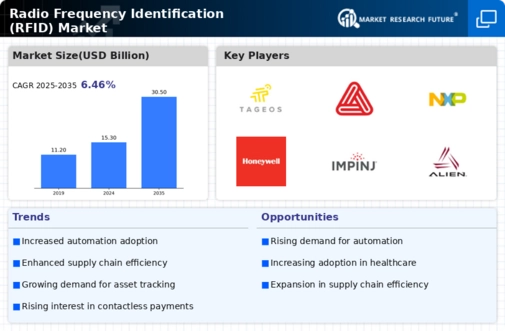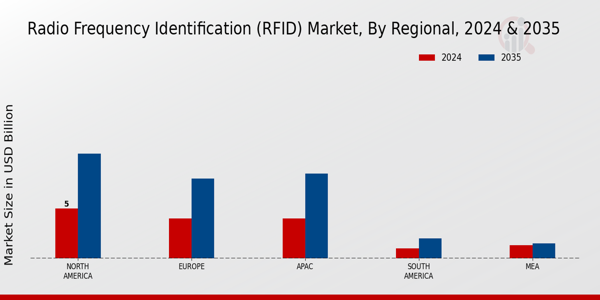Regulatory Support
Government regulations promoting the use of RFID technology in various industries are bolstering the Global Radio Frequency Identification (RFID) Market Industry. Regulatory bodies are increasingly recognizing the benefits of RFID in enhancing traceability and security, particularly in sectors such as healthcare and food safety. For example, initiatives aimed at improving food traceability have led to the adoption of RFID systems in supply chains. This regulatory support is likely to facilitate market expansion, contributing to a compound annual growth rate (CAGR) of 6.46% from 2025 to 2035.
Technological Advancements
The Global Radio Frequency Identification (RFID) Market Industry is experiencing rapid technological advancements, which are enhancing the capabilities and applications of RFID systems. Innovations such as the development of passive RFID tags that can operate without batteries and the integration of RFID with IoT technologies are driving market growth. These advancements enable real-time tracking and inventory management across various sectors, including retail and logistics. As a result, the market is projected to reach 15.3 USD Billion in 2024, reflecting a growing demand for efficient supply chain solutions.
Increased Adoption in Retail
The retail sector is increasingly adopting RFID technology to improve inventory accuracy and enhance customer experience. The Global Radio Frequency Identification (RFID) Market Industry indicates that retailers are utilizing RFID for real-time inventory tracking, which reduces stock discrepancies and enhances operational efficiency. For instance, major retailers have reported inventory accuracy rates exceeding 95 percent after implementing RFID systems. This trend is expected to contribute significantly to the market's growth, with projections indicating a rise to 30.5 USD Billion by 2035, driven by the need for improved supply chain management.
Emerging Applications in Healthcare
The healthcare sector is witnessing a surge in the adoption of RFID technology, which is transforming patient care and asset management. The Global Radio Frequency Identification (RFID) Market Industry highlights the use of RFID for tracking medical equipment, medications, and even patients. This technology enhances operational efficiency and improves patient safety by reducing errors associated with medication administration. As healthcare providers increasingly recognize the benefits of RFID, the market is expected to experience significant growth, contributing to the overall expansion of the industry.
Growing Demand for Supply Chain Efficiency
The demand for enhanced supply chain efficiency is a significant driver of the Global Radio Frequency Identification (RFID) Market Industry. Organizations are increasingly seeking solutions to streamline operations and reduce costs, leading to a higher adoption of RFID technology. By providing real-time visibility into inventory levels and asset locations, RFID systems enable companies to optimize their supply chains. This trend is particularly evident in logistics and manufacturing sectors, where efficiency gains can lead to substantial cost savings. As a result, the market is poised for robust growth, with expectations of reaching 30.5 USD Billion by 2035.





















Leave a Comment